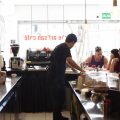The future is bright for specialty coffee in Quito.
In the last 10 years, specialty coffee shops are mushrooming all across the city. In Pichincha and Imbabura, a small group of pioneering coffee farmers is making an impact in coffee production. These two provinces close to Quito have excellent climate and volcanic soil for coffee plantations.
Quito is 9,400 feet above sea level. It takes a special skill to pull a great cup of espresso in high altitude (see note below). And the baristas in Quito will show you how.
If you are visiting Quito, here’s a list of recommended places to find your perfect cup of joe:
1. The Coffeeteer
With the purpose of promoting Ecuadorian grown coffee starting in 2014, The Coffeeteer is quickly becoming one of the top coffee shops in Quito. Sourcing their coffee from coffee farmers in Pichincha and Imbabura provinces, The Coffeeteer is able to serve up fresh and high-quality coffee every day to local coffee enthusiasts and tourists.
On their menu are cappuccino, mochaccino, espresso, black coffee and Ecuadorian desserts.
Opening hours: Monday to Saturday from 8:30 a.m. to 7:30 p.m.
Location: Jorge Washington E5 29, Quito
More information: The Coffeeteer Facebook page
2. Cafe Traviesa
Besides being one of the best specialty coffee shops and coffee roasters in Quito, Traviesa is a learning center. Coffee enthusiasts, barista wannabes or anyone aspiring to be in the specialty coffee industry should check out Traviesa’s ongoing workshops. You can also bring back a bag or two of their freshly roasted Ecuadorian coffee as souvenirs for your friends.
Stepping into Traviesa, you’ll be transported to a different environment compared to shops in Quito. It feels like any specialty coffee shop in the US, Australia or the UK. They even have flat white on the menu! Traviesa coffee beans are sourced from local producers in Imbabura and Pichincha provinces. And also from the regions of Carchi, Loja and Zamora Chinchipe. Expect to find coffee from Africa too.
On their menu are espresso, macchiato, cappuccino, flat white, baked goods, and more.
Opening hours: Monday to Friday from 10 a.m. to 9 p.m., Saturday from 10 a.m. to 9 p.m. Sunday closed
Location: Humboldt N27-77 and San Ignacio, Quito
More information: Traviesa
3. Xoco Caffe
Xoco Caffe uses Italian-style roasted coffee (dark roast) with notes of chocolate and walnut. When asked what their top sellers are, Xoco Caffe included cardamom Americano, macchiato, hazelnut cappuccino and shakerato (espresso with sweetened condensed milk).
Xoco Caffe offers parking, which is quite a luxury in Quito.
Opening hours: Monday to Friday from 10 a.m. to 8 p.m.
Location: Edificio Mirage (Mirage Building), Av. October 12th and Lincoln, Quito
More information: Xoco Caffe Facebook page
4. Botanica
Botanica offers a special deal where $5 will get you a coffee and a dessert. Choose espresso, ristretto, macchiato, cortadito, americano, latte, flat white, mocha or milk with any dessert on the menu of your choice.
There’s outdoor and indoor seating available at Botanica. Expect a friendly atmosphere and well maintained vertical garden at Botanica. In addition to coffee and dessert, Botanica has a variety of sandwiches and healthy snacks.
Opening hours: 11 a.m. to 10:30 p.m.
Location: Guipuzcoa E14-104 and Coruna, Quito
More information: Botanica Facebook page
5. The Coffee Academy
Open since March 2013, The Coffee Academy is a coffee shop and a barista training school. Located inside Los Hemisferios University campus, it is popular among students and local residents. Their top sellers are nutellaccino, mochaccino, espresso, and cappuccino.
Opening hours: Daily from 7 a.m. to 8 p.m.
Location: Paseo de la Universidad, No, 300 and Juan Diaz, Quito
More information: The Coffee Academy Facebook page
6. Cedron, Casa Gangotena
Even if you’re not staying at Casa Gangotena you may want to pop by for their afternoon tea. Casa Gangotena is the only place in Quito that offers a traditional English afternoon tea. Instead of tea, coffee lovers may like a cappuccino.
Afternoon coffee, or as our friend likes to call it, “cafecito” usually falls between 5 to 6 p.m. During “cafecito” time they serve coffee with cheese, cookies, and assorted bread.
Hours of operation (afternoon tea time): Daily 4-6 p.m.
Location: At the lobby, in front of the restaurant Cedrón, Casa Gangotena, Bolivar Oe6-41 y Cuenca
Quito
More information: Afternoon tea at Casa Gangotena
7. Cafe Plaza Grande
Located in the historic Hotel Plaza Grande, Cafe Plaza Grande has an old-time feel. The decor, chairs, and tables evoke warm memories of days gone by. Most seats offer views of the Government Palace and Independence Square, Quito’s main square.
On their menu is a special coffee called Café de Cantuña. Café de Cantuña is made with Sambuca (a type of liquor) and café cosecha roja, a gourmet Ecuadorian 100% Arabica coffee. Basically, it is espresso served with chantilly cream and Sambuca.
Pulling espresso at 9,400 feet above sea level
Drinking espresso in Quito (9,400 feet elevation), the capital city of Ecuador helped us understand more about the art and science of pulling espresso. Did you notice the bubbles in your espresso today? Are they as big as the ones we saw in our cup at high altitude?
The big bubbles in espresso are formed because of the lower atmospheric pressure. Lower pressure means more carbon dioxide in the water during brewing. According to coffee experts, pulling espresso shots in high altitudes is different from sea level. You can read about the reason behind the big bubbles on Reddit.
Traveling to Quito anytime soon? Before you leave, here are 2 recommended books to read:
Lonely Planet Ecuador and Galapagos Islands
Lonely Planet Latin American Spanish Phrasebook and Dictionary
P.S. We want to thank The Coffeeteer, Cafe Traviesa, Xoco Caffe, Botanica and The Coffee Academy for providing photographs for this blog post.
